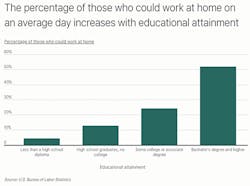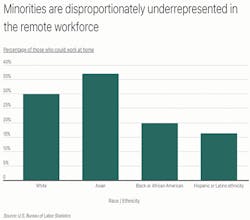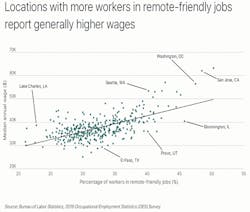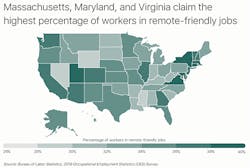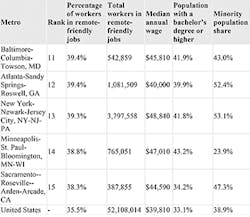In a nationwide effort to slow the spread of COVID-19, millions of Americans have transitioned to remote work. NEW and impending vaccines may leave many wondering whether the influx of remote work will recede with the virus.
Some companies have already committed to remote working conditions beyond 2020 — even permanently — but there are several jobs that simply cannot be carried out from home.
Those who work in maintenance, food preparation, construction, and much of the healthcare industry are often (or always) required to physically be somewhere other than home.
InvisiLight® Solution for Deploying Fiber
April 2, 2022Go to Market Faster. Speed up Network Deployment
April 2, 2022Episode 10: Fiber Optic Closure Specs Explained…
April 1, 2022Food for Thought from Our 2022 ICT Visionaries
April 1, 2022Still, approximately one-third of all jobs can be conducted remotely. Analyzing 2 surveys conducted by the Occupational Information Network, researchers at the University of Chicago formulated a work-from-home measure for each of 22 major occupational groups.
Using that measure and recent employment data from the U.S. Bureau of Labor Statistics (BLS), researchers at Outdoorsy calculated the percentage of each U.S. metropolitan area’s workforce that can conduct work exclusively from home. Applying educational attainment, wage, and minority population data to the analysis, researchers identified some key takeaways.
EDUCATION ATTAINMENT
As it turns out, educational attainment is a strong predictor of the ability to work remote. Citing responses provided in the annual American Time Use Survey (ATUS), the BLS discovered that the percentage of workers who could do at least some work from home on an average day increases significantly based on educational attainment. While less than 5% of workers who did not finish high school report being capable of doing some work from home, more than 50% of those with a bachelor’s degree or higher could.
MINORITY POPULATIONS
Educational attainment is not the only predictive measure of remote work. The ATUS found that certain minorities were disproportionately underrepresented in the potential remote workforce. Overall, only 16.2%of Hispanic or Latino workers and 19.7% of Black or African American workers report being able to do some of their work from home compared to 29.9% and 37% of White and Asian workers, respectively.
In addition to occupation, living arrangements — including access to computers and broadband Internet — may impact the ability of many minorities to work remotely. Pew Research found that prior to the pandemic, only 57% of Hispanics and 58% of Blacks had access to a computer at home compared to 82% of whites.
WAGES
The ability to work from home has not only kept millions of Americans employed this year, remote work is also financially rewarding. While remote jobs make up 35.5% of all US employment, they account for 45.8% of all US wages. As a result, locations throughout the country with higher percentages of workers in remote-friendly occupations report generally higher median annual wages.
STATE LEVEL
The prevalence of remote work varies significantly at the state level. Massachusetts, Maryland, and Virginia top the list of states with the highest percentage of workers in remote-friendly jobs, reporting 40.2%, 39.6% and 38.9%, respectively. Utah, Colorado, Washington, and California also show high percentages, all ranking in the top 10. The lowest percentage of workers in remote-friendly jobs — just 29.7% — is in Mississippi.
METROPOLITAN AREAS
To find the metropolitan areas with the most remote-friendly jobs, researchers at Outdoorsy analyzed the most recent employment data from the BLS’s 2019 Occupational Employment (OES) Survey. A work-from-home measure that rates an occupation’s viability for remote work created by the Booth School of Business at the University of Chicago was used to calculate the percentage of workers in remote-friendly jobs in each metro. Researchers ranked metros accordingly.
Only metros with at least 100,000 residents were included in the report. Additionally, separate rankings were generated for small (100,000–349,999 residents), midsize (350,000–999,999 residents), and large (1,000,000 residents or more) metropolitan areas.
Here are the large metros with the highest percentage of workers in remote-friendly jobs.
For more information, a detailed methodology, and complete results, you can find the original report on Outdoorsy’s website: https://www.outdoorsy.com/blog/top-remote-friendly-cities









